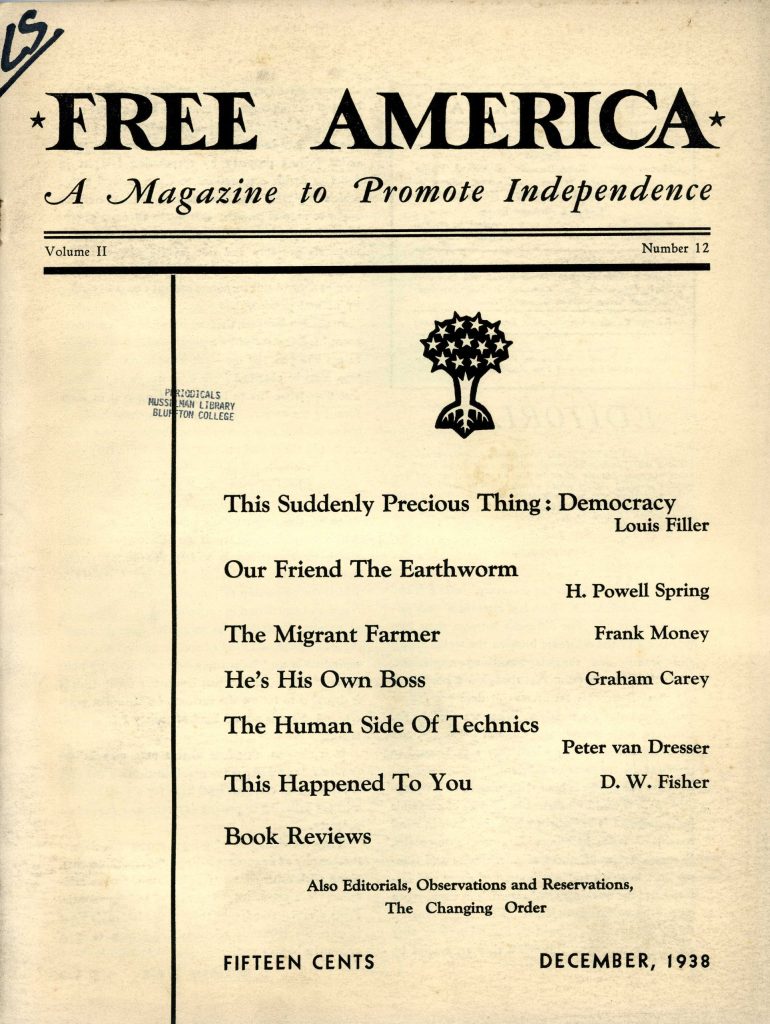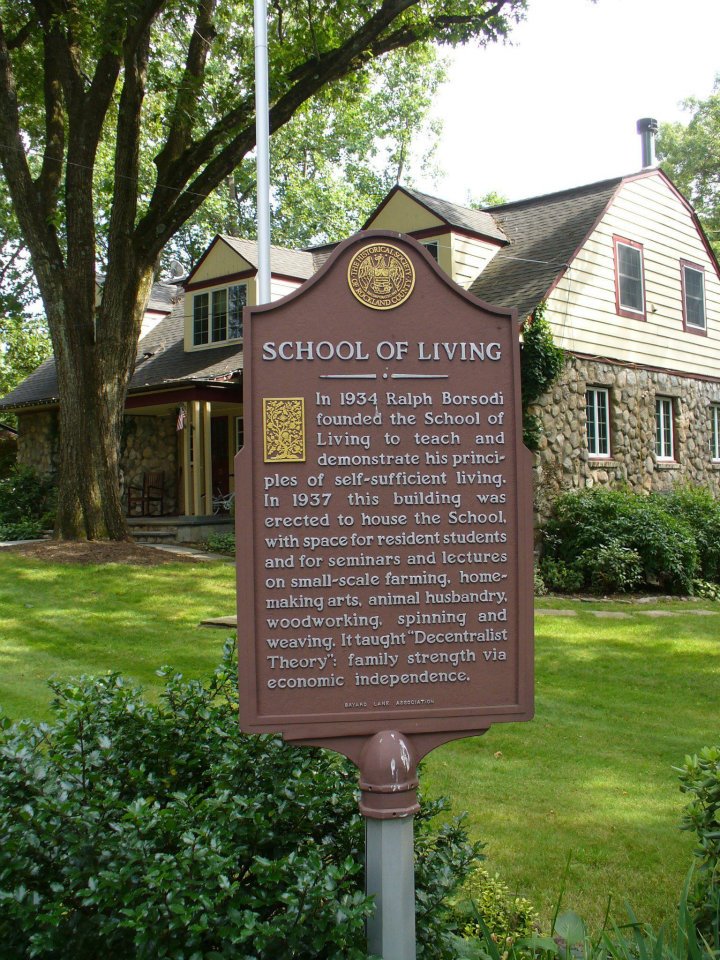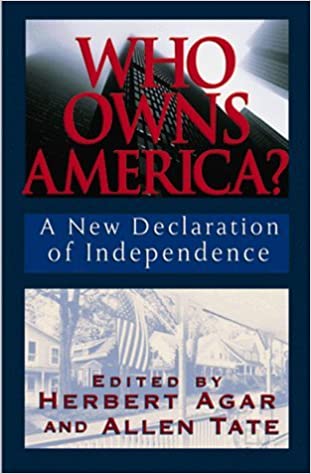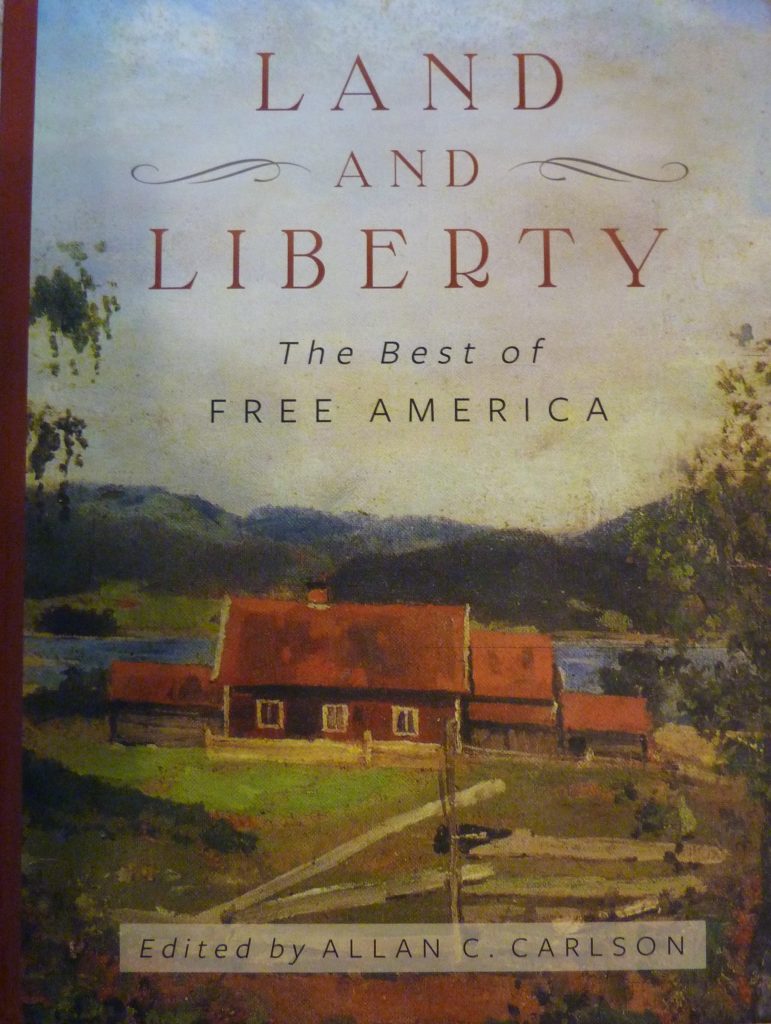Jackson, MI. In his Afterword to Land & Liberty: The Best of Free America, James Matthew Wilson notes that the Front Porch Republic is, in many respects, “closely modeled on Free America.” While the teetering stacks on your nightstand probably don’t include back issues of this journal, which was published from 1937 to 1947, Allan Carlson has gathered notable selections and published them in a handsome volume. Perusing these articles from eighty years ago reminds us that advocates for decentralization have a long history to draw on. Many of the current debates that animate postliberal conversations rehash ground covered in the pages of Free America, and a familiarity with these past conversations provides a necessary historical ballast for today’s discussions.
The essays included in this volume are helpfully framed by Roger Scruton’s Preface, Carlson’s Introduction, and Wilson’s Afterword. These all serve to situate Free America within its broader tradition and show how it remains relevant. The journal was founded to carry on the conversation begun by Georgist economists, the British Distributists, the Southern Agrarians, and others interested in the possibility of decentralization. While the Roaring Twenties fueled optimism about the benefits of industrialism, the Depression exposed the hollow promises of that decade’s techno-utopianism. In the 1930s, then, decentralists found a receptive audience. If Free America was, in part, a response to what Herbert Agar calls “the high unpleasant noon of Coolidge prosperity” (3), and the counter-culture of the 60s, from which Wendell Berry and E.F Schumacher emerged, was a response to the post-war industrial boom, perhaps the Front Porch Republic and its localist allies are a similar response to the housing bubble that popped in 2008 and the larger crises it exposed. Scruton summarizes the foundational commitments that undergird the journal and its decentralist heirs: “The real wealth of a country . . . does not reside in the hectic exchanges on the stock market or the rivers of commodities that flow through every household without belonging there. It resides in local communities, in the work that holds them together, and the deep investment represented by a home, a place and the endowment across generations of human love” (x).
The 1936 book Who Owns America? A Declaration of Independence was a manifesto of sorts, and Free America continued the collaboration that book began between Herbert Agar, the Southern Agrarians, and their fellow-travelers. Carlson identifies three guiding spirits behind the magazine, each bringing a different set of emphases. The first was Ralph Borsodi. He initially worked as a marketing and advertising consultant, but after moving to a seven-acre farm with his wife and family, he began to re-think this line of work. For instance, Borsodi calculated that 70% of most industrial products’ cost “was comprised of transportation, storage, and advertising expenses” (xiv). These costs are required to turn something into a commodity that can be exchanged for money, but they don’t increase a product’s use-value at all. In fact, in the case of food production, they decrease its use-value by making the products less nutritious and flavorful.
Borsodi was also influenced by the economist Henry George, who advocated a single land tax designed to discourage speculative property ownership. The other economic influences behind Free America were the British Distributists and the Southern Agrarians. Herbert Agar was the key figure in uniting these two groups. He became an editor at G. K.’s Weekly, and working with Chesterton and Hilaire Belloc soon converted him to distributist principles and the conviction that productive property must be widely distributed. This vision had an early American proponent in Thomas Jefferson, but Agar argued that Jefferson eventually betrayed his agrarian ideals and went along with “greedy, middle-class Hamiltonian capitalism” (xv). Agar edited Who Owns America? with Allen Tate, which included essays by Belloc and many of the Southern Agrarians.

The chief financial clout behind the magazine came from Chauncey Stillman. He belonged to an upper-crust New York family, trained as an architect, and became interested in Rudolf Steiner’s system of biodynamic farming. He purchased the property that became Wethersfield and founded the Homeland Foundation, which supported research and education to improve rural life. In the wake of the 1936 publication of Who Owns America?, Stillman agreed to fund a monthly magazine to promote these decentralist ideals. Thus Free America was born. Its editorial principles, as distilled by Carlson, should sound familiar to Porchers: “productive property—homesteads, land, tools, and natural resources—must be widely distributed to enable a regime of liberty and democracy to flourish” (xxi).
Productive Property
Throughout its decade of publication, the journal remained committed to the belief that property’s true importance lies in its use-value rather than its exchange-value. The political implications of this commitment can be seen in Agar’s opening editorial proclamation that “without economic democracy there can be neither social nor political democracy.” And “wherever democracy has weakened in the modern world, the property-system has weakened first” (5). He expands on this connection in a later essay: “So the argument comes back to moral and political grounds. Can the American desire for justice, liberty, democracy, be realized in a true property state? Are there strong reasons for thinking it cannot be realized in any other form of state? Are the American people capable of the political effort to make their desires come true?” (80). The ways in which we order our economy have fundamental political and moral implications, and a healthy democracy requires that its citizens have access to productive property. As another contributor writes, “property is essential to liberty. Mere political liberty, the liberty of propertyless, atomized human dust to cast ballots and talk their own (and other peoples’) heads off in futile political ‘free speech’ is not real liberty—it is a grim caricature of the genuine article” (12). Members of today’s precariat class may be able to buy iPhones and eat avocado toast, but they are not free; they are wage slaves who are vulnerable to the whims of global capital.
Widely distributed productive property is not only necessary for political liberty, it is also necessary for a truly humane society. To be fully human, one must have opportunities to make and create. As Allen Tate explains, Jefferson’s ideal requires “a system of property in which ownership is so widely distributed that the owners . . . are compelled to exert responsible moral control over the portion of the means of production that they happen to own” (140). Baker Brownell echoes this sentiment in his essay, “New Agrarian Art”: “Art burns in the people. Not only in the more formal arts, but in the homely skills and gestures of every day, it is a deep reality” (29). One of the marks of a healthy society is that its members have the freedom and resources to get their livelihoods and to contribute to their communities.

For Free America, the paradigmatic example of productive property is a plot of land on which to grow a garden or keep some chickens, but other forms abound: a sewing machine by which to make clothes for use or sale; pots, a stove, and a refrigerator to make meals; a well-stocked shop to make furniture; an instrument which can produce beautiful music; even the computer on which I’m typing this essay is a piece of property that enables me to produce things of value (more on computers as productive property below). Perhaps one way of distinguishing between productive property and exchange-value property or inert commodities is by way of Albert Borgmann’s distinction between focal things and devices. Focal things, like productive property, require attention and skill to use well. Devices, on the other hand, promise to make things “instantaneous, ubiquitous, safe, and easy.” A humane society is built around the former. An industrial capitalist society is built around the latter. GDP, of course, ignores much of the activity involving productive property; as Thomas Haile notes, “Professional economists . . . concern themselves only with exchange values. They consistently ignore all production which is for use rather than for exchange” (39).
One of the interesting projects that grew from this concern with productive property was the “Productive Home Architectural Competition.” The magazine offered cash prizes for home designs intended to support a thriving household economy. Acknowledging that this would look different in different locales, they broke the country into five sections and offered a top prize in each region. The results were quite interesting, and Carlson includes the blueprints for the winning designs. This competition put forward an alternative vision to what Peter Van Dresser calls the “sleeping-dressing-feeding cubicle” (174). Unfortunately, American architects have not, for the most part, followed this vision for productive households, and most houses are designed to be sleeping-dressing-feeding-amusement cubicles. The result is not only a dependence on cheap transportation; we are also vulnerable to economic disruptions or—as we are now discovering—global pandemics. Interconnected regional economies in which households produce much of what they need are more resilient than a centralized global economy.
Shifting Battle Lines
The intellectual battles fought in the pages of Free America took place along different lines than do the political and economic discussions of the twenty-first century, but it’s precisely because the landscape was markedly different that surveying it from the distance of eighty years proves so instructive. Part of the impetus for forming the journal was that the editor of the American Review, an earlier journal with agrarian and distributist sympathies, announced himself to be a fascist in 1936 (xix). Agar and Tate wanted to advocate decentralism as necessary for a thriving democracy and to position economic and political decentralism as an alternative to the growing specters of fascism and communism in Europe and of industrial capitalism in America.
John Camberlain summarizes their thinking in his review of Agar’s The Pursuit of Happiness: “If democracy means freedom from political coercion, it also means freedom from economic coercion” (142). Such economic coercion could occur under communism, fascism, or a political democracy dominated by finance-capitalism. Today’s debates seem to pit liberalism against various postliberalisms, but these older and different debates are important reminders not to get sucked into the issues of the moment but to remember the longer conversations from which they have descended.
At times, these essays fall into too-simple dichotomies: the agrarian South is good; the industrial North is bad. The metropolis is bad; the farmer is good. These simplifications can lead to faulty analysis. Walter Marx, for instance, makes some sound observations about the effects of tractors on agriculture, noting that “once the American farmer buys machines his sons have to get jobs in factories to help pay for them.” And “the moment when large-scale mechanized agriculture exhausts the soil or fails to obtain semi-servile labor it is doomed” (49). Yet his essay ends with a pernicious contrast between the sterile “white race” and the “prolific peoples of the East” that is disturbing, to say the least.
As C.S. Lewis points out with regard to reading old books, however, these are different errors than we are likely to make today, and their praise of decentralism, creative making-do, and distributed economic productivity flow from a perennial wisdom that is too often forgotten today as finance-capitalism continues to concentrate property and power in the hands of a few. In Breaking Bread with the Dead Alan Jacobs cites L.P. Hartley’s famed quip: “The past is a foreign country; they do things differently there.” Jacobs continues, “Which of course doesn’t mean that what ‘they do’ is always right—but awareness of it is always illuminating, and often liberating” (15).
Paradoxes
The most illuminating debates in these pages play out around a set of three paradoxes. All three of these involve a tension between means and ends. The first is what role central governmental policies might play in creating a more distributed economy. The second is whether industrial technologies—and electrical technologies in particular—could end up serving decentralized production. And the final tension, one which plays out mostly behind the scenes, is whether decentralized arguments should be advanced through explicitly religious justifications. Contributors differed on all these questions, and these disagreements lend an intellectual vitality to this collection of articles. On the one hand, some aligned themselves with the position Wendell Berry would take several decades later in “Discipline and Hope”: “Hope lives in the means, not the ends.” Others, however, thought that the only way to unwind a centralized, technological society is by taking advantage of its tools and turning them against the secular leviathan.
Political
The New Deal provided an opportunity to ponder whether Washington D.C. could further decentralist goals. As Carlson puts it, these authors asked: “How might great concentrations of economic power inherited from prior decades be broken? Was it possible for agrarian, distributist, and decentralist goals to be achieved through governmental programs?” (117). Those who answered in the affirmative acknowledged the challenges. Several pointed to the Tennessee Valley Association as an example of a federal program that would make a struggling region more economically self-sufficient. As Ralph Woods argued in this regard, “It is a legitimate function of government to construct the requisite mosaic, lay down the fundamental principles, suggest the directions to be followed, and outline desirable policies” (157). Power and transportation infrastructure are “‘natural’ monopolies” that are best managed by a central government.
Today, some might argue along similar lines that healthcare has become a natural monopoly. Though all three, in their present form, are bloated, centralized, and, in some respects, destructive, it is hard to see how privatization would decentralize or improve them. The key question is what overarching plans and centralized services liberate people to make their property productive? This question also animates recent debates regarding a potential Green New Deal or other infrastructure programs.
In a similar vein, Elizabeth Graham praised policies that, in the first third of the twentieth century, decentralized property ownership in Scandinavia. Land consolidation can be banned and taxed and reversed by government policies. Articles like these demonstrate that rethinking national tax policy can lead to the redistribution of property; central planning can facilitate decentralization. And of course industrial capitalism and huge corporations benefit immensely from the current regulatory regime. In the words of Borsodi, “We do not need legislation so much to promote decentralization, as we need legislation which will end the taxes, subsidies, and monopolies by which alone abnormal centralization is able to survive” (127).
Yet the agrarian Donald Davidson was hesitant to look for help from the federal government. As he wrote, “The New Deal would alter the ends for which the machinery of industrial civilization has been operating, substituting love of the general interest for love of the specific, love of the good life, conceived in national terms, above the baser motives of mere luxury, profit, and power. Can this be done by the identical means long used for other ends?” Hence Davidson is skeptical of the way in which the New Deal “seems to accept ‘bigness,’ on the assumption that, by changes of mechanism or of regulation, large industrial operations can be made to deliver technological benefits and at the same time behave ethically. But big business, a little mended, a little regulated, and heavily supported, has merely taken advantage of its spell of security to line its pockets in the old manner” (132). Davidson cites Ruskin on the need to make our means fit the desired ends. If the end is love and health, we can’t simply use mass industrial means; this, of course, is Berry’s point as well. Thus Davidson concludes: “Agrarian statecraft would seek to make its expedients conform to this principle: that the inculcation of ethics begins in the daily task of the worker, the farmer, the businessman.” This is a rousing sentiment, and right as far as it goes, but it’s woefully light on detail. What would an agrarian New Deal look like?
Even if decentralists had a difficult time articulating their desired alternatives to Roosevelt’s economic programs, their warnings about the dangers of centralized political power should be heeded. Agar wrote in 1938 that the coming years may see America “accept some form of tyranny as the sole way of putting the power of politics above the power of money,” and yet he continues to hope for the victory of democracy rooted in distributed property (21). Many postliberal nationalists and integralists today want to seize the levers of political power as the only way to combat unchecked global capital, but Agar reminds us that we ought to resist both centralized politics and centralized economics. Agar repeatedly warns against the reformer’s fond hope that “a few more laws will make everything rosy” or that if we just had the right “Strong Man,” we could bring about an equal, just society through coercive means (21). His warnings remain necessary in our own time, when one president is hailed as the Messiah and his successor, while purportedly promising drastically different policies, similarly presents himself as the only person who can make America great again. Agar points out that strong-arm political tactics, even in the service of purportedly good ends, would fundamentally destroy the hope of a Jeffersonian republic:
The devil will gladly help us, at his usual price—we shall have to hand him our soul. The devil can put our men to work; there is no unemployment in Germany or in Russia. The devil can make economics the servant of politics; no one tells Hitler or Stalin that “economic law” prevents a needed reform, for such advice leads to jail. But the devil will walk off with our national soul. There will be no more talk, then, about “equal rights for all,” or about freedom, or democracy. America may flourish; but the American experiment will have come to an end. (23)

Agar sounded a similar warning in his contribution to Who Owns America?. He wrote there that
if fascism comes to America, it . . . will come as it came to Europe, as a revolt of the lower middle class, of the people who want to be self-respecting proprietors, but who find themselves dispossessed—proletarian in fact, but not in feeling. These people are easy game for the demagogue, for the man who will promise them the moon and promise it quickly, who will tell the desperate middle class that the problem of making them all kings, or all financially independent, is perfectly simple. . . . And when the demagogue comes to power, he will find that his “age of plenty” is not so easy to provide. At that point fascism is born. At that point the demagogue, threatened with a breakdown of the whole economic system, turns to the [capitalist] Lords and Masters whom he has been abusing, and makes a deal. The demagogue stays in office and keeps the people quiet. The Lords and Masters stay in power and run the economic system just the way they always wanted to run it. The corporate State is monopoly-capitalism made safe, monopoly-capitalism with the whole power of society behind it. (131-32)
Contributors to Free America hoped New Deal policies could be structured to serve decentralist ends, but they were clear-eyed about the dangers that centralized power poses to a democracy whose health depends on widely-distributed property. Certain forms of political power, like Tolkien’s one ring, cannot be wielded well.
Technological
The second animating paradox in the pages of Free America is the hope that some forms of modern technology might actually facilitate decentralized production. In his Afterword, Wilson calls this the Cushman Coyle hypothesis (328). David Cushman Coyle’s essay “The Fallacy of Mass Production” in Who Owns America? articulated this possibility; if steam power and early industrial factories were inhumane and inevitably centralizing, perhaps electricity and new forms technology can “redeem” the free market. Wilson summarizes this hope: “our increasing refinement of industrial technology will inevitably enlarge the number of property-owning families and diffuse productive home industry on an unprecedented scale” (329).
On a systemic level, Peter Van Dresser argued in several essays that electricity held great promise: power could be transmitted relatively cheaply and easily put to use in home and small manufacturing facilities. Such regionalized production would be more efficient and resilient. He insists, therefore, that “decentralism” is not code for a bucolic, back-to-the-land idealism:
the full implications of the decentralist philosophy are of tremendous importance today, suggesting perhaps the only coherent, integrated program for democratic national policy in a world struggling with the collapse of the mercantilist order, the only technique for uniting effectively the overwhelming majority of free peoples in the world against the minority who have fallen under the temporary madness of fascism. The absolutely essential readjustment of industry to a balanced regional economy, the liquidation of excessive centralized plant and organization built around the concept of mercantile imperialism (whether that imperialism be internal and interregional, or international), the wider distribution of the tools of technological production and the income from their use—such problems as these must be at the focus of effective decentralist thought. (304)
Dresser’s program resonates with proposals made by many of today’s critics of globalization, but most contributors to Free America were focused not on developing a “coherent, integrated program for democratic national policy” but on ways that families could produce more of their own goods. Borsodi delighted in detailing the ways in which modern technologies like electric grain mills, refrigerators, and home canners had made home production easier. He points out that “in case after case, the mass production of goods is less economical than small-scale custom or family production” (96). Hence, as he claims in another essay, “to repudiate centralization is not to repudiate progress” (122). Baker Brownell waxes positively rhapsodic over the possibilities of a “machine regionalism”:
The machine, in short, is not only the creator of the great city and its centralizations; it will also be the agency of decentralization and the disintegration of the city. . . . A new machine regionalism already is developing. . . . Because centralized production of automobiles or of machine tools is more efficient does not mean that centralized production of food stuffs, music, drama, textiles, dancing, furniture, education, amusement, pottery, sport, conversation, horticulture products, literature, housing and life itself is also inevitable and desirable. Life is practice; art is practice. (170)
Brownell is certainly right that the centralization of all life is not desirable, but the development of technology over the eighty years since he wrote this has not exactly fulfilled his optimistic vision. FAANG has accumulated unbelievable amounts of data and capital, and the silicon age is no less centralized than the Fordist age. Nevertheless, widespread electricity and internet do have decentralist possibilities: Etsy, 3-D printing, makerspaces, affordable power tools—opportunities abound for small-scale or household production. And computers enable a growing number of people to work from their home offices during the morning and farm, parent, or work with their hands in the afternoons. While we have lost much of the embodied knowledge required to raise our food or hone a craft, books and YouTube make it possible for motivated people to learn these skills.
Yet are these exceptions that prove the rule? Are we misguided to think that Berry’s maxim about means and ends doesn’t always hold, and that sometimes we can use centrally-manufactured and distributed technologies to decentralize productive property? As Wilson concludes his assessment of these questions, “the verdict delivered by computer technology is mixed on this point” (332). The kinds of opportunities sketched by Borsodi and others remain possibilities, but not probabilities. They are grounds for hope, not for optimism.
Religious
The tensions regarding religion are the main burden of Wilson’s Afterword. He focuses on Catholic contributors who collaborated with non-Christians in advocating for decentralization: “Their faith was that decentralization of population and property, the restoration of subsistent agriculture and home industry, a generally democratic sensibility that prizes being able to do things and make things (including works of fine art) for oneself, creates a pattern or rhythm of living that will orient the person to an end beyond it” (330). And in particular, a religious end. Wilson acknowledges that this approach is always a kind of gamble: “To argue for a specific form without reference to the final end intended is always a risk and has perhaps not been successful in convincing others to adopt one’s principles. But . . . it may have been the only means of argument available in a liberal society intrinsically suspicious of every reference to an ultimate end, purpose, or destiny” (331). For Allen Tate, political decentralism did turn out to be a back door into the church, but is his biography once again the exception that proves the rule?
Nevertheless, the Front Porch Republic project itself has taken a similar approach. While led in large part by confessional Christians, it has always sought to build alliances with and welcome fellow-travelers from different religious perspectives. Porchers have certainly not spoken with a singular voice on religious questions (or much else, for that matter); fierce debates have played out in these virtual pages. The same was true of Free America. As their concluding editorial states, “A unanimity of conviction on fundamentals among its editors and high mutual regard has allowed free play to a diversity of opinion that was invigorating and often hilarious” (xxv).
A Good Fellowship Fighting the Long Defeat
After finishing this collection of essays, it is this sense of an invigorating community with which I was left. Vigorous debates play out out in these pages, but the contributors were united by their willingness to wage what Tolkien calls “the long defeat.” Their conviviality in this endeavor reminds me of David Heddendorf’s tribute to a storied literary periodical: such magazines can foster a genuine community of fellow-travelers. They bring readers and writers together to journey alongside one another through seasons of history. The final editorial, announcing the end of the project, elaborated on these higher goods of friendship: “Free America has always been managed and issued in an atmosphere of comradeship. . . . We trust some of this happy atmosphere has radiated through the medium of print. . . . Let our last words be that it has been worthwhile and good fun to put out Free America with and for people devoted to this high cause.”
It seems that even a losing cause can foster rich fellowship. Moreover, being on the wrong side of history doesn’t mean that you are, in fact, on the losing side. Andy Catlett realizes this in Remembering while arguing with his editor at Scientific Farming: “That an argument was losing did not mean that it should not be made. It had already been made and it would be made again, not because he would make it, but because it existed, it always had, and he belonged to it. . . . That it was losing did not mean it was beaten.” The contributors to Free America belonged to one another and to the vision of a humane society, one founded on distributed property. Just because this vision has been drowned out by the purveyors of the bigger-is-better and the latest-is-greatest doesn’t mean a decentralist vision is not worth defending and, even more so, practicing. This anthology bears witness to the rich fellowship that those who belong to this vision have inherited.








4 comments
Dominic Garzonio
Looking forward to the new edition. Seems to address a couple of points about decentralization/distributism that I’ve been wrestling with for awhile now: 1) The possible role of the federal government in such a project and 2) The place of someone like myself (an agnostic-atheist or, as you put it Jeff, “fellow-traveler from [a] different religious perspective”). Thanks for the review!
Rob G
Great — thanks.
Rob G
Jeff, is this book available yet? I can’t seem to find it online anywhere, even for pre-order.
Jeffrey Bilbro
It’s not widely available yet (I probably should have mentioned this). Allan tells me that they had to work out some copyright issues, but a new printing is forthcoming. I’ll try to post a link when that printing comes out.
Comments are closed.